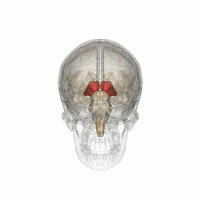
Photo from wikipedia
Background MRI-guided focused US thalamotomy of ventral intermediate nucleus of the thalamus is a treatment for tremor disorders. Purpose To evaluate white matter integrity before and after thalamotomy and its… Click to show full abstract
Background MRI-guided focused US thalamotomy of ventral intermediate nucleus of the thalamus is a treatment for tremor disorders. Purpose To evaluate white matter integrity before and after thalamotomy and its correlation with clinical outcome. Materials and Methods Participants with essential tremor (ET) or Parkinson disease (PD) undergoing thalamotomy were prospectively recruited between March 2016 and October 2018. Tremor and quality of life were assessed before, 1 month after, and 6 months after thalamotomy. Participants underwent T1-weighted, T2-weighted fluid-attenuated image recovery, and diffusion-tensor MRI before and 1 day, 7-10 days, 1-3 months, and 6 months or longer after treatment. Diffusivity and fiber tractography measures were calculated. Repeated measures analysis of variance with post hoc paired t test and Skillings-Mack test with post hoc Wilcoxon signed-rank test were used for normally and nonnormally distributed data, respectively, and Bonferroni method corrected for multiple comparisons. Results Twenty-two study participants with ET (mean age, 72 years ± 6 [standard deviation]; 14 men), 17 participants with PD (mean age, 65 years ± 8; 13 men), and a replication set of 17 participants with ET (mean age, 73 years ± 6; 10 men) were evaluated. Long-term damage was found in the ablated core (mean fractional anisotropy [FA] at baseline, 0.41 ± 0.10, and at ≥6 months, 0.23 ± 0.09; P < .001) and thalamus to red nucleus tract (mean number of tracts at baseline, 1663, and at ≥6 months, 1070; P = .003). Negative correlation was observed between motor thalamus FA 1 day after ablation and tremor improvement (ET: R = -0.52 [P = .03]; PD: R = -0.61 [P = .003]). Better tremor relief in ET was associated with lower fractional anisotropy before treatment (R = -0.5; P = .02). Conclusion MRI-guided focused US thalamotomy resulted in short- and long-term white-matter changes. Diffusion-tensor imaging provided evidence for long-term damage in the ablation core and in the thalamus and red nucleus tract, and a correlation between preablation fractional anisotropy in the motor thalamus and clinical outcome. © RSNA, 2020 Online supplemental material is available for this article.
Journal Title: Radiology
Year Published: 2020
Link to full text (if available)
Share on Social Media: Sign Up to like & get
recommendations!